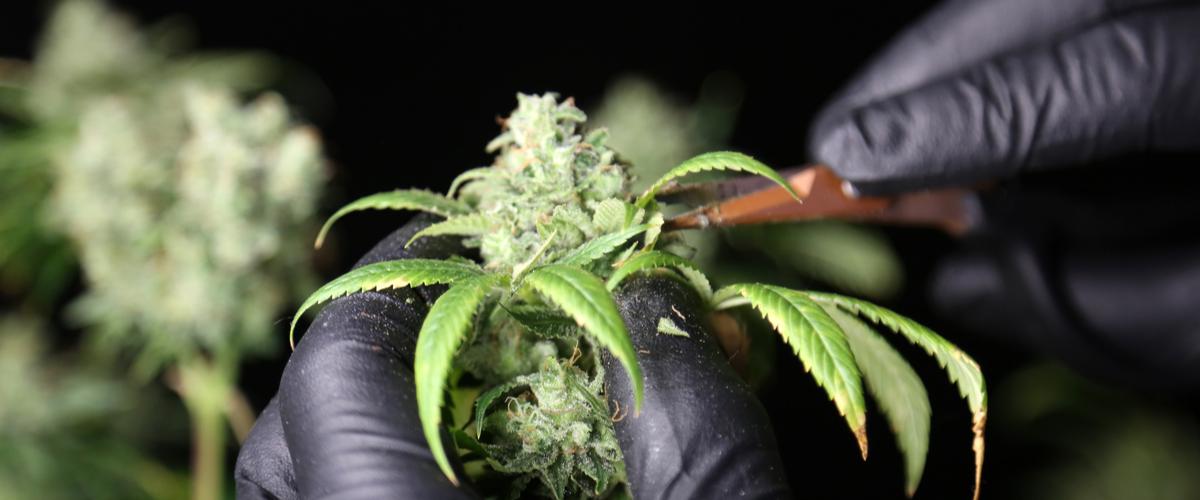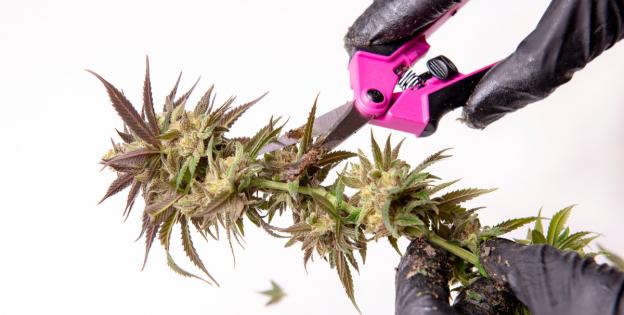- Cannabis growing is comprised of several stages, all of which are equally important when it comes to producing high-quality, abundant crops.
- Oftentimes, novice growers try their best during the actual growing stage, mistakenly thinking that once they’ve cut down their plants all that is left to do is hang them to dry.
- But because they mark the culmination of the growing cycle, post-harvest stages are just as important as the actual growing phase. Read on for a comparison of dry and wet trimming and discover the pros and cons of both methods.

As cannabis growing becomes increasingly popular, growers across the world are taking an increasing interest in trimming, producing flowers of ever-growing quality. Sadly, all approaches come with their pros and cons and there's no such thing as the perfect method. Take a look at the guide below to help you choose the trimming technique that might work best for you.
Dry trimming
Highly popular among small growers, dry trimming involves cutting down the plants and hanging them to dry for some 20-30 days before actually starting to trim. Even so, you'll still have to remove fan leaves in order to reduce humidity levels and favour the plant's metabolic processes – e.g. the gas exchanges that determine the flavours, aromas and effects of cannabis. This is a vital stage during which the flowers evolve gradually as they dry.

The more leafy the flowers, the higher the humidity and, thus, also the risk of mould growth. On the positive side, metabolic processes like gas exchanges are slower in buds that are surrounded by foliage. As a result, the organoleptic profile is subtler and more complex than with wet trimming, which tends to produce flavours, aromas and effects that are not as intense.
Another upside to dry trimming is that the leaves protect the flowers from damage during transport and handling of the plants, ensuring all their qualities are preserved, for example, the terpenes and the quality of the resin. The chief drawback to working in dry conditions is that the process takes much longer because the leaves are brittle and prone to breaking.
Dry trimming is particularly well suited to small grows, where priority is given to quality and the final product often meets the standards of international cannabis competitions like the High Times Cannabis Cup. One final point: trimming machines provide significantly better results when the buds are fresh and thus are not recommended for dry trimming.
Pros:
- Flowers and extracts exhibit better overall properties
- Improved aroma
- Improved flavour
- Effects get more intense and complex
- Cannabis cup-grade quality
Cons:
- Increased risk of mould growth
- Flowers dry more slowly
- Process takes longer than wet trimming
- Suitable only for small cannabis grows
Wet trimming
Common among small growers, wet trimming is the preferred choice of large-scale producers as it allows to process large amounts of flowers in little time, while ensuring a healthy, mould free final product. Trimming in wet conditions involves removing the leaves immediately after cutting down the plants, when the water content is still high. Frequently, this is performed with the aid of a machine trimmer that has been specifically designed for large-scale cannabis production. Many growers in the industry, however, prefer to have specialist workers do the work manually.
By removing the leaves from the buds prior to trimming, the humidity is drastically reduced, which results in a significantly lower risk of mould. Highly efficient and safe, wet trimming is a great way to ensure the profitability of large-scale cannabis growing businesses.

Because their establishment requires a large initial investment, losing a crop partially or in full is something professional growers cannot afford, so it is only natural that they take whatever measures they can to prevent such an economic disaster.
As for the quality of the final product, if the trimming is performed by a team of workers, it won't differ much from that of dry trimmed buds. On the contrary, if machine trimmers are used, the result won't be as polished – machines slightly alter bag appeal and cause some resin and terpene loss.
While advancements in technology have led to the development of ever sophisticated trimmers, steel cannot match the delicacy of a human hand, which in turn will never be as fast and constant as a machine. But whether manual or mechanical, dry trimming will always be a faster method than dry trimming.
Pros:
- Process is faster
- Risk of mould growth is dramatically lower
- Flowers dry faster
- Optimised yields
- Compatible with machine trimmers
- Suitable both for small and large cannabis grows
Cons:
- Flowers and extracts are of slightly lower quality
- Small loss of resin and terpenes
- Flavours, aromas and effects are somewhat less complex and intense
- OK but not great bag appeal
With both methods, you can save the trim and use it for extract and concentrates of different types. Again, there's no such thing as the perfect method, so the choice will ultimately come down to your priorities and specific needs.




Comments from our readers
There are no comments yet. Would you like to be the first?
Leave a comment!Did you like this post?
Your opinion about our seeds is very important to us and can help other users a lot (your email address won't be made public).